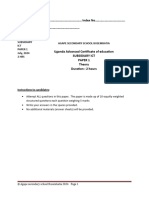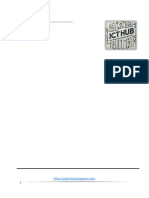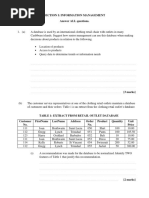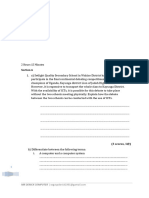Component 1 SAM
Component 1 SAM
Uploaded by
StevenBentonCopyright:
Available Formats
Component 1 SAM
Component 1 SAM
Uploaded by
StevenBentonCopyright
Available Formats
Share this document
Did you find this document useful?
Is this content inappropriate?
Copyright:
Available Formats
Component 1 SAM
Component 1 SAM
Uploaded by
StevenBentonCopyright:
Available Formats
AS COMPUTER SCIENCE Specimen Assessment Materials 5
Candidate Name Centre Number Candidate Number
AS COMPUTER SCIENCE
COMPONENT 1
Fundamentals of Computer Science
SPECIMEN PAPER
2 hours
INSTRUCTIONS TO CANDIDATES
Answer ALL questions.
Write your name, centre number and candidate number in the spaces at the top of this page.
Write your answers in the spaces provided in this booklet.
INFORMATION FOR CANDIDATES
The number of marks is given in brackets at the end of each question or part-question. You
are advised to divide your time accordingly.
The total number of marks available is 100.
You are reminded of the need for good English and orderly, clear presentation in your
answers.
No certificate will be awarded to a candidate detected in any unfair practice during the
examination.
© WJEC CBAC Ltd.
AS COMPUTER SCIENCE Specimen Assessment Materials 6
Answer all questions
1. Below is an incomplete diagram of a typical Von Neumann architecture computer.
CPU
Input Register Output
A
Memory
(a) Identify and explain the function of components A and B above. [4]
…………………………………………………………………………………………
…………………………………………………………………………………………
…………………………………………………………………………………………
…………………………………………………………………………………………
…………………………………………………………………………………………
…………………………………………………………………………………………
…………………………………………………………………………………………
…………………………………………………………………………………………
…………………………………………………………………………………………
…………………………………………………………………………………………
…………………………………………………………………………………………
…………………………………………………………………………………………
…………………………………………………………………………………………
…………………………………………………………………………………………
…………………………………………………………………………………………
…………………………………………………………………………………………
…………………………………………………………………………………………
…………………………………………………………………………………………
© WJEC CBAC Ltd.
AS COMPUTER SCIENCE Specimen Assessment Materials 7
(b) The following data is stored in a 16-bit register.
1001 0110 1101 1011
Name the logical operation and draw the truth table required to clear this register.
Include a worked example of clearing the register with the data above. [3]
…………………………………………………………………………………………………
…………………………………………………………………………………………………
…………………………………………………………………………………………………
…………………………………………………………………………………………………
…………………………………………………………………………………………………
…………………………………………………………………………………………………
…………………………………………………………………………………………………
…………………………………………………………………………………………………
…………………………………………………………………………………………………
…………………………………………………………………………………………………
…………………………………………………………………………………………………
…………………………………………………………………………………………………
…………………………………………………………………………………………………
…………………………………………………………………………………………………
…………………………………………………………………………………………………
© WJEC CBAC Ltd.
AS COMPUTER SCIENCE Specimen Assessment Materials 8
2. (a) Describe the importance of standard network protocols. [2]
………………………………………………………………………………………………
………………………………………………………………………………………………
………………………………………………………………………………………………
………………………………………………………………………………………………
………………………………………………………………………………………………
………………………………………………………………………………………………
(b) Describe the use of the following protocols: [3]
(i) IMAP: …………………………………………………………………………….
………………………………………………………………………………………………
………………………………………………………………………………………………
(ii) DHCP: ……………………………………………………………………………
………………………………………………………………………………………………
………………………………………………………………………………………………
(iii) UDP: ……………………………………………………………………………..
………………………………………………………………………………………………
………………………………………………………………………………………………
© WJEC CBAC Ltd.
AS COMPUTER SCIENCE Specimen Assessment Materials 9
3. Related data stored on a computer system can become fragmented over time.
(a) Explain what is meant by the term fragmentation and give one possible effect.
[2]
…………………………………………………………………………………………………..
…………………………………………………………………………………………………..
…………………………………………………………………………………………………..
…………………………………………………………………………………………………..
(b)Discuss the issues surrounding the defragmentation of a Solid State Drive (SSD).
[3]
…………………………………………………………………………………………………..
…………………………………………………………………………………………………..
…………………………………………………………………………………………………..
…………………………………………………………………………………………………..
…………………………………………………………………………………………………..
…………………………………………………………………………………………………..
…………………………………………………………………………………………………..
…………………………………………………………………………………………………..
…………………………………………………………………………………………………..
…………………………………………………………………………………………………..
…………………………………………………………………………………………………..
…………………………………………………………………………………………………..
© WJEC CBAC Ltd.
AS COMPUTER SCIENCE Specimen Assessment Materials 10
4. (a) Different data transmission methods are used by computer systems. Identify
the most suitable transmission method for the following scenarios and explain
their suitability.
(i) Sending sound to a speaker system. [3]
…………………………………………………………………………………………
…………………………………………………………………………………………
…………………………………………………………………………………………
…………………………………………………………………………………………
(ii) A video conferencing call. [3]
…………………………………………………………………………………………
…………………………………………………………………………………………
…………………………………………………………………………………………
…………………………………………………………………………………………
(b) Describe what is meant by the terms multiplexing and switching. [3]
…........................................................................................................................
…........................................................................................................................
…........................................................................................................................
...........................................................................................................................
…........................................................................................................................
…........................................................................................................................
…........................................................................................................................
(c) Identify three typical items contained in a TCP/IP packet and describe their
purpose. [6]
…....................................................................................................................................
…....................................................................................................................................
…....................................................................................................................................
…....................................................................................................................................
…....................................................................................................................................
…....................................................................................................................................
…....................................................................................................................................
…....................................................................................................................................
© WJEC CBAC Ltd.
AS COMPUTER SCIENCE Specimen Assessment Materials 11
5. (a) Using binary addition, calculate the number that would result from adding
00100101 and 00111100
Convert the result into hexadecimal. [2]
…………………………………………………………………………………………………..
…………………………………………………………………………………………………..
…………………………………………………………………………………………………..
…………………………………………………………………………………………………..
…………………………………………………………………………………………………..
………………………………………………………………………………………………….
(b) Assuming that 1 is used to indicate a negative number, show how the negative
number -1310 will be represented using sign/magnitude in an 8 bit register. [1]
…………………………………………………………………………………………………..
…………………………………………………………………………………………………..
…………………………………………………………………………………………………..
…………………………………………………………………………………………………..
(c) Integers can also be represented using two’s complementation.
Describe, using an example, how the two’s complement of a binary number is
derived. [2]
…………………………………………………………………………………………………..
…………………………………………………………………………………………………..
…………………………………………………………………………………………………..
…………………………………………………………………………………………………..
…………………………………………………………………………………………………..
…………………………………………………………………………………………………..
© WJEC CBAC Ltd.
AS COMPUTER SCIENCE Specimen Assessment Materials 12
(d) (i) Give an advantage and disadvantage of using floating point form rather than
integer form. [2]
………………………………………………………………………………………….
………………………………………………………………………………………….
………………………………………………………………………………………….
(ii) Real numbers stored in floating point form can be stored using 16 bits as
shown below:
Mantissa Exponent
(12 bits in two’s complement form. The binary (4 bits in two’s
point in the mantissa is immediately after the left complement form.)
bit.)
Convert the number 63.25 into this floating point form. [2]
………………………………………………………………………………………….
………………………………………………………………………………………….
………………………………………………………………………………………….
………………………………………………………………………………………….
(iii) In a different computer system, the following is a floating point representation
of a number, using an 8 bit mantissa and a 4 bit exponent:
0•1011000 0101
Calculate the mantissa, exponent and decimal equivalent of the number. [3]
………………………………………………………………………………………….
…………………………………………………………………………………………
…………………………………………………………………………………………
…..…………………………………………………………………………………….
© WJEC CBAC Ltd.
AS COMPUTER SCIENCE Specimen Assessment Materials 13
6. Using Boolean algebra, simplify the following:
(A + C).(A.D + A.D) + A.C + C
[7]
…………………………………………………………………………………………………..
…………………………………………………………………………………………………..
…………………………………………………………………………………………………..
…………………………………………………………………………………………………..
…………………………………………………………………………………………………..
…………………………………………………………………………………………………..
…………………………………………………………………………………………………..
…………………………………………………………………………………………………..
…………………………………………………………………………………………………..
…………………………………………………………………………………………………..
…………………………………………………………………………………………………..
…………………………………………………………………………………………………..
…………………………………………………………………………………………………..
…………………………………………………………………………………………………..
…………………………………………………………………………………………………..
…………………………………………………………………………………………………..
…………………………………………………………………………………………………..
…………………………………………………………………………………………………..
…………………………………………………………………………………………………..
…………………………………………………………………………………………………..
…………………………………………………………………………………………………..
…………………………………………………………………………………………………..
…………………………………………………………………………………………………..
…………………………………………………………………………………………………..
© WJEC CBAC Ltd.
AS COMPUTER SCIENCE Specimen Assessment Materials 14
7. When writing a program, a programmer could use a low level language or a high
level language.
Give three advantages for each of these approaches.
[6]
………………………………………………………………………………………………………
………………………………………………………………………………………………………
………………………………………………………………………………………………………
………………………………………………………………………………………………………
………………………………………………………………………………………………………
………………………………………………………………………………………………………
………………………………………………………………………………………………………
………………………………………………………………………………………………………
………………………………………………………………………………………………………
………………………………………………………………………………………………………
………………………………………………………………………………………………………
………………………………………………………………………………………………………
………………………………………………………………………………………………………
………………………………………………………………………………………………………
………………………………………………………………………………………………………
………………………………………………………………………………………………………
………………………………………………………………………………………………………
………………………………………………………………………………………………………
………………………………………………………………………………………………………
………………………………………………………………………………………………………
………………………………………………………………………………………………………
………………………………………………………………………………………………………
………………………………………………………………………………………………………
………………………………………………………………………………………………………
………………………………………………………………………………………………………
© WJEC CBAC Ltd.
AS COMPUTER SCIENCE Specimen Assessment Materials 15
8. Scientists monitoring the level of a pollutant in the air take a number of readings and
use a computer to analyse the data.
Write an algorithm, using pseudo-code, with the following inputs:
the number of readings to be analysed
the readings themselves as whole numbers
The algorithm should read the readings into an array then output:
the mean of the readings
how many readings were above the mean
the highest reading
Your algorithm must be written using self-documenting identifiers.
[7]
………………………………………………………………………………………………………………………………………………..
………………………………………………………………………………………………………………………………………………..
……………………………………………………………………………………………………………………………………………….
……………………………………………………………………………………………………………………………………………….
……………………………………………………………………………………………………………………………………………….
……………………………………………………………………………………………………………………………………………….
……………………………………………………………………………………………………………………………………………….
………………………………………………………………………………………………………………………………………………..
………………………………………………………………………………………………………………………………………………..
……………………………………………………………………………………………………………………………………………….
……………………………………………………………………………………………………………………………………………….
……………………………………………………………………………………………………………………………………………….
……………………………………………………………………………………………………………………………………………….
……………………………………………………………………………………………………………………………………………….
………………………………………………………………………………………………………………………………………………..
………………………………………………………………………………………………………………………………………………..
……………………………………………………………………………………………………………………………………………….
……………………………………………………………………………………………………………………………………………….
……………………………………………………………………………………………………………………………………………….
……………………………………………………………………………………………………………………………………………….
© WJEC CBAC Ltd.
AS COMPUTER SCIENCE Specimen Assessment Materials 16
9. Explain the role of an Integrated Development Environment (IDE). Describe the
purpose of three typical features of an IDE. [4]
………………………………………………………………………………………………….……
………………………………………………………………………………………………….……
………………………………………………………………………………………………….……
………………………………………………………………………………………………….……
………………………………………………………………………………………………….……
………………………………………………………………………………………………….……
………………………………………………………………………………………………….……
………………………………………………………………………………………………….……
………………………………………………………………………………………………….……
………………………………………………………………………………………………….……
………………………………………………………………………………………………….……
………………………………………………………………………………………………….……
………………………………………………………………………………………………….……
………………………………………………………………………………………………….……
………………………………………………………………………………………………….……
………………………………………………………………………………………………….……
© WJEC CBAC Ltd.
AS COMPUTER SCIENCE Specimen Assessment Materials 17
10. (a) Explain how a bubble sort operates. [2]
.......................................................................................................................................
.......................................................................................................................................
.......................................................................................................................................
.......................................................................................................................................
.......................................................................................................................................
.......................................................................................................................................
(b) An algorithm is written for a bubble sort in one particular application. The
input to the algorithm is a set of 6 positive integers.
One set of data which would test this algorithm is:
BubbleSortArray
45 32 5 35 19 62
(0) (1) (2) (3) (4) (5)
Write down two other sets of data which will more fully test the algorithm. [2]
DataSet1
(0) (1) (2) (3) (4) (5)
DataSet2
(0) (1) (2) (3) (4) (5)
© WJEC CBAC Ltd.
AS COMPUTER SCIENCE Specimen Assessment Materials 18
11. Summarise how an operating system manages computer resources. [8]
….………………………………………………………………………………………………
.…………………………………………………………………………………………………
.…………………………………………………………………………………………………
.…………………………………………………………………………………………………
.…………………………………………………………………………………………………
.…………………………………………………………………………………………………
.…………………………………………………………………………………………………
.…………………………………………………………………………………………………
.…………………………………………………………………………………………………
.…………………………………………………………………………………………………
.…………………………………………………………………………………………………
.…………………………………………………………………………………………………
.…………………………………………………………………………………………………
.…………………………………………………………………………………………………
.…………………………………………………………………………………………………
.…………………………………………………………………………………………………
.…………………………………………………………………………………………………
.…………………………………………………………………………………………………
.…………………………………………………………………………………………………
.…………………………………………………………………………………………………
.…………………………………………………………………………………………………
.…………………………………………………………………………………………………
.…………………………………………………………………………………………………
.…………………………………………………………………………………………………
.…………………………………………………………………………………………………
.…………………………………………………………………………………………………
.…………………………………………………………………………………………………
© WJEC CBAC Ltd.
AS COMPUTER SCIENCE Specimen Assessment Materials 19
12. An organisation is responsible for paying its employees and calculating their tax and
national insurance. Each employee is paid a different hourly rate.
The employee pay details, including their hourly rate are stored in a master file. The
number of hours each employee works each month is entered and stored in a
transaction file.
At the end of each month the hours worked by the employee and the hourly rate are
used to calculate the month’s pay, tax and national insurance.
(a) Explain why sequential file organisation is the most suitable for the master file
and why serial file organisation is the most suitable for the transaction file. [2]
……………………….......................................................................................................
……………………….......................................................................................................
……………………….......................................................................................................
……………………….......................................................................................................
……………………….......................................................................................................
(b) Give one item of data that would appear in both the transaction file and the
master file. [1]
…………………………………………………………………………………………………..
…………………………………………………………………………………………………..
(c) Draw a clearly labelled diagram below which shows how the transaction file
and the master file are used to produce a pay slip for every employee. [4]
© WJEC CBAC Ltd.
AS COMPUTER SCIENCE Specimen Assessment Materials 20
13. Before new computer systems are introduced in an organisation, different methods of
changeover are considered.
Compare two methods of changeover and consider processes that would protect the
security and integrity of data during changeover.
You should draw on your knowledge, skills and understanding from a number of
areas across your Computer Science course when answering this question. [13]
….……………………………………………………………………………………………………
….……………………………………………………………………………………………………
….……………………………………………………………………………………………………
….……………………………………………………………………………………………………
….……………………………………………………………………………………………………
….……………………………………………………………………………………………………
….……………………………………………………………………………………………………
….……………………………………………………………………………………………………
….……………………………………………………………………………………………………
….……………………………………………………………………………………………………
….……………………………………………………………………………………………………
….……………………………………………………………………………………………………
….……………………………………………………………………………………………………
….……………………………………………………………………………………………………
….……………………………………………………………………………………………………
….……………………………………………………………………………………………………
….……………………………………………………………………………………………………
….……………………………………………………………………………………………………
….……………………………………………………………………………………………………
….……………………………………………………………………………………………………
….……………………………………………………………………………………………………
….……………………………………………………………………………………………………
….……………………………………………………………………………………………………
….……………………………………………………………………………………………………
….……………………………………………………………………………………………………
….……………………………………………………………………………………………………
© WJEC CBAC Ltd.
AS COMPUTER SCIENCE Specimen Assessment Materials 21
….……………………………………………………………………………………………………
….……………………………………………………………………………………………………
….……………………………………………………………………………………………………
….……………………………………………………………………………………………………
….……………………………………………………………………………………………………
….……………………………………………………………………………………………………
….……………………………………………………………………………………………………
….……………………………………………………………………………………………………
….……………………………………………………………………………………………………
….……………………………………………………………………………………………………
….……………………………………………………………………………………………………
….……………………………………………………………………………………………………
….……………………………………………………………………………………………………
….……………………………………………………………………………………………………
….……………………………………………………………………………………………………
….……………………………………………………………………………………………………
….……………………………………………………………………………………………………
….……………………………………………………………………………………………………
….……………………………………………………………………………………………………
….……………………………………………………………………………………………………
….……………………………………………………………………………………………………
….……………………………………………………………………………………………………
….……………………………………………………………………………………………………
….……………………………………………………………………………………………………
….……………………………………………………………………………………………………
….……………………………………………………………………………………………………
….……………………………………………………………………………………………………
….……………………………………………………………………………………………………
….……………………………………………………………………………………………………
….……………………………………………………………………………………………………
END OF PAPER
© WJEC CBAC Ltd.
You might also like
- Barracuda Web Application Firewall Best Practices Guide PDFNo ratings yetBarracuda Web Application Firewall Best Practices Guide PDF14 pages
- ICT Basics Practise Paper - Level 3 IT TechnicalsNo ratings yetICT Basics Practise Paper - Level 3 IT Technicals8 pages
- Unit h046 1 Computing Principles Sample Assessment MaterialsNo ratings yetUnit h046 1 Computing Principles Sample Assessment Materials37 pages
- S5 SUBSIDIARY ICT THEORY End of Tern Two Examinations 2022 BIYAYA SECONDARY SCHOOL100% (3)S5 SUBSIDIARY ICT THEORY End of Tern Two Examinations 2022 BIYAYA SECONDARY SCHOOL9 pages
- Name: . Stream : S 850/1 Subsidiary Information & Communication Technology Paper 1 2 Hours100% (1)Name: . Stream : S 850/1 Subsidiary Information & Communication Technology Paper 1 2 Hours6 pages
- Turbo School: Computer Studies Contest 5 Term Two 2024No ratings yetTurbo School: Computer Studies Contest 5 Term Two 20247 pages
- Computer Studies Revision Kits Form 3 2022 Term 2 Paper 1 Model17092022007-2No ratings yetComputer Studies Revision Kits Form 3 2022 Term 2 Paper 1 Model17092022007-222 pages
- Robotics, Monitoring and Control Systems QuestionsNo ratings yetRobotics, Monitoring and Control Systems Questions8 pages
- CAPE Information Technology Unit 2 Trial ExamNo ratings yetCAPE Information Technology Unit 2 Trial Exam11 pages
- Molo District Mock Examination Kenya Certificate of Secondary Education 2008No ratings yetMolo District Mock Examination Kenya Certificate of Secondary Education 200812 pages
- Kiira College Butiki: Name: House Signature: ..Stream100% (1)Kiira College Butiki: Name: House Signature: ..Stream9 pages
- 15.1 5009 - Activity 11 - Lighting in Buildings - S221No ratings yet15.1 5009 - Activity 11 - Lighting in Buildings - S2214 pages
- ICT Paper 1 WESTERN JOINT MOCK EXAMINATIONSNo ratings yetICT Paper 1 WESTERN JOINT MOCK EXAMINATIONS10 pages
- G9 Revision Worksheet Question Paper First TermNo ratings yetG9 Revision Worksheet Question Paper First Term6 pages
- Ac11eb40 5d3e 48ff b191 782a552b964a S4 Aceiteka 2023 Agriculture P2No ratings yetAc11eb40 5d3e 48ff b191 782a552b964a S4 Aceiteka 2023 Agriculture P27 pages
- ST Thomas Aquinas College Erepi S.5 Ict End of Term Two ExamsNo ratings yetST Thomas Aquinas College Erepi S.5 Ict End of Term Two Exams8 pages
- Evergreen Corporation: Sti College Santa Rosa, Laguna100% (1)Evergreen Corporation: Sti College Santa Rosa, Laguna16 pages
- Online Room - INFORMATION - SYSTEM - PROJect ReportNo ratings yetOnline Room - INFORMATION - SYSTEM - PROJect Report113 pages
- PfSense Bandwidth Management - How To Configure The Traffic ShaperNo ratings yetPfSense Bandwidth Management - How To Configure The Traffic Shaper6 pages
- M4U Home System: We Simplify Management Task For YouNo ratings yetM4U Home System: We Simplify Management Task For You2 pages
- How Cisco Operationalizes Social Media For Repeated SuccessNo ratings yetHow Cisco Operationalizes Social Media For Repeated Success26 pages
- Lesson Plan - December 1-31, 2017 - FinalNo ratings yetLesson Plan - December 1-31, 2017 - Final3 pages
- Jadwal Piket Shift Operator Gardu Induk TessNo ratings yetJadwal Piket Shift Operator Gardu Induk Tess6 pages
- Infrastructure As A Service Using StackNo ratings yetInfrastructure As A Service Using Stack16 pages
- Implementing Self-Service Procurement in ERP - SAP DocumentationNo ratings yetImplementing Self-Service Procurement in ERP - SAP Documentation3 pages
- (SQL Notes) - TheTestingAcademy - Pramod - Google DriveNo ratings yet(SQL Notes) - TheTestingAcademy - Pramod - Google Drive20 pages
- How To Use Apache Jmeter To Perform Load Testing On A Web ServerNo ratings yetHow To Use Apache Jmeter To Perform Load Testing On A Web Server32 pages
- Reality Reinvented: Presented By: Paridhi Juneja Roll NoNo ratings yetReality Reinvented: Presented By: Paridhi Juneja Roll No24 pages
- Reducing Ping-Pong Handovers in LTE by Using A1-Based MeasurementsNo ratings yetReducing Ping-Pong Handovers in LTE by Using A1-Based Measurements6 pages
- GeoMax Zenith 25 GPS GSM Profile and Bluetooth GuideNo ratings yetGeoMax Zenith 25 GPS GSM Profile and Bluetooth Guide25 pages
- 10 Sn2073eu01sn 0002 App Local Number PortabilityNo ratings yet10 Sn2073eu01sn 0002 App Local Number Portability24 pages
- Barracuda Web Application Firewall Best Practices Guide PDFBarracuda Web Application Firewall Best Practices Guide PDF
- Unit h046 1 Computing Principles Sample Assessment MaterialsUnit h046 1 Computing Principles Sample Assessment Materials
- S5 SUBSIDIARY ICT THEORY End of Tern Two Examinations 2022 BIYAYA SECONDARY SCHOOLS5 SUBSIDIARY ICT THEORY End of Tern Two Examinations 2022 BIYAYA SECONDARY SCHOOL
- Name: . Stream : S 850/1 Subsidiary Information & Communication Technology Paper 1 2 HoursName: . Stream : S 850/1 Subsidiary Information & Communication Technology Paper 1 2 Hours
- Turbo School: Computer Studies Contest 5 Term Two 2024Turbo School: Computer Studies Contest 5 Term Two 2024
- Computer Studies Revision Kits Form 3 2022 Term 2 Paper 1 Model17092022007-2Computer Studies Revision Kits Form 3 2022 Term 2 Paper 1 Model17092022007-2
- Robotics, Monitoring and Control Systems QuestionsRobotics, Monitoring and Control Systems Questions
- Molo District Mock Examination Kenya Certificate of Secondary Education 2008Molo District Mock Examination Kenya Certificate of Secondary Education 2008
- Kiira College Butiki: Name: House Signature: ..StreamKiira College Butiki: Name: House Signature: ..Stream
- 15.1 5009 - Activity 11 - Lighting in Buildings - S22115.1 5009 - Activity 11 - Lighting in Buildings - S221
- Ac11eb40 5d3e 48ff b191 782a552b964a S4 Aceiteka 2023 Agriculture P2Ac11eb40 5d3e 48ff b191 782a552b964a S4 Aceiteka 2023 Agriculture P2
- ST Thomas Aquinas College Erepi S.5 Ict End of Term Two ExamsST Thomas Aquinas College Erepi S.5 Ict End of Term Two Exams
- Evergreen Corporation: Sti College Santa Rosa, LagunaEvergreen Corporation: Sti College Santa Rosa, Laguna
- Online Room - INFORMATION - SYSTEM - PROJect ReportOnline Room - INFORMATION - SYSTEM - PROJect Report
- PfSense Bandwidth Management - How To Configure The Traffic ShaperPfSense Bandwidth Management - How To Configure The Traffic Shaper
- M4U Home System: We Simplify Management Task For YouM4U Home System: We Simplify Management Task For You
- How Cisco Operationalizes Social Media For Repeated SuccessHow Cisco Operationalizes Social Media For Repeated Success
- Implementing Self-Service Procurement in ERP - SAP DocumentationImplementing Self-Service Procurement in ERP - SAP Documentation
- (SQL Notes) - TheTestingAcademy - Pramod - Google Drive(SQL Notes) - TheTestingAcademy - Pramod - Google Drive
- How To Use Apache Jmeter To Perform Load Testing On A Web ServerHow To Use Apache Jmeter To Perform Load Testing On A Web Server
- Reality Reinvented: Presented By: Paridhi Juneja Roll NoReality Reinvented: Presented By: Paridhi Juneja Roll No
- Reducing Ping-Pong Handovers in LTE by Using A1-Based MeasurementsReducing Ping-Pong Handovers in LTE by Using A1-Based Measurements
- GeoMax Zenith 25 GPS GSM Profile and Bluetooth GuideGeoMax Zenith 25 GPS GSM Profile and Bluetooth Guide

























































































